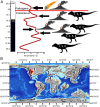Asteroid impact, not volcanism, caused the end-Cretaceous dinosaur extinction
- PMID: 32601204
- PMCID: PMC7382232
- DOI: 10.1073/pnas.2006087117
Asteroid impact, not volcanism, caused the end-Cretaceous dinosaur extinction
Abstract
The Cretaceous/Paleogene mass extinction, 66 Ma, included the demise of non-avian dinosaurs. Intense debate has focused on the relative roles of Deccan volcanism and the Chicxulub asteroid impact as kill mechanisms for this event. Here, we combine fossil-occurrence data with paleoclimate and habitat suitability models to evaluate dinosaur habitability in the wake of various asteroid impact and Deccan volcanism scenarios. Asteroid impact models generate a prolonged cold winter that suppresses potential global dinosaur habitats. Conversely, long-term forcing from Deccan volcanism (carbon dioxide [CO2]-induced warming) leads to increased habitat suitability. Short-term (aerosol cooling) volcanism still allows equatorial habitability. These results support the asteroid impact as the main driver of the non-avian dinosaur extinction. By contrast, induced warming from volcanism mitigated the most extreme effects of asteroid impact, potentially reducing the extinction severity.
Keywords: Chicxulub; Deccan; Dinosauria; end-Cretaceous; extinction.
Copyright © 2020 the Author(s). Published by PNAS.
Conflict of interest statement
The authors declare no competing interest.
Figures




References
-
- Raup D. M., Sepkoski J. J. Jr., Mass extinctions in the marine fossil record. Science 215, 1501–1503 (1982). - PubMed
-
- Fastovsky D. E., Sheehan P. M., The extinction of the dinosaurs in North America. GSA Today 15, 4 (2005).
-
- Schulte P. et al. ., The Chicxulub asteroid impact and mass extinction at the Cretaceous-Paleogene boundary. Science 327, 1214–1218 (2010). - PubMed
-
- Archibald J. D. et al. ., Cretaceous extinctions: Multiple causes. Science 328, 973 (2010). - PubMed
Publication types
MeSH terms
Substances
Associated data
- figshare/10.6084/m9.figshare.11908179
- figshare/10.6084/m9.figshare.11908203
- figshare/10.6084/m9.figshare.11908227
- figshare/10.6084/m9.figshare.11908284
- figshare/10.6084/m9.figshare.11908266
- figshare/10.6084/m9.figshare.11908305
- figshare/10.6084/m9.figshare.11908311
- figshare/10.6084/m9.figshare.11908365
- figshare/10.6084/m9.figshare.11908368
- figshare/10.6084/m9.figshare.11908374
- figshare/10.6084/m9.figshare.11908407
- figshare/10.6084/m9.figshare.11908416
- figshare/10.6084/m9.figshare.11908422
- figshare/10.6084/m9.figshare.11908437
LinkOut - more resources
Full Text Sources

